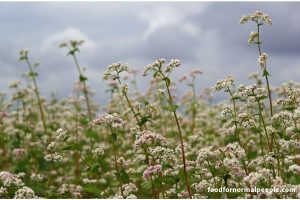Over a decade ago, before I began my gluten-free journey, I didn’t really know what buckwheat was. Now, it’s become a part of my kitchen store and I add it while baking different kinds of gluten-free bread. But why is buckwheat experiencing a big comeback? In the second article in this series on gluten-free super grains, I take a look at a crop that has accompanied us from ancient times.
Gluten-free super grains: Amaranth
There are mainly two types of buckwheat: common buckwheat (Fagopyrum esculentum) and tartary buckwheat (Fagopyrum tartaricum). The main difference between the two varieties is their breeding system and preferred climate. Tartary buckwheat is a self-fertile plant, which means it can self-produce, or inbreed using its own pollen. It is also frost resistant, making it suitable to grow in colder climates.
Despite its name, buckwheat is not related to wheat and is not a cereal grain. Instead, it is classified as a “pseudograin.” According to the Food and Agricultural Organization (FAO), common buckwheat is native to western China, Tibet and eastern India and is also cultivated in the cool and moist climes of Russia, central and southeastern Asia, Europe and USA.
This gluten-free super grain is an annual plant, with reddish stems and white to pink flowers. The buckwheat plant has multiple uses: its tender shoots are eaten as leafy vegetables, the green leaves are used medicinally to promote circulation and the grains are used to prepare buckwheat flour as well as for feeding livestock.
History
The Whole Grains Council states that buckwheat was cultivated in northern China as early as 4000 BCE, and in southwestern China and the Tibet/Himalayan region around 2000 BCE. From there, it spread to the Caucasus and eastwards to Japan.
Significant buckwheat production was not seen in Europe and Russia until the 16th century, but archaeologists have documented evidence of buckwheat pollen in Eastern Europe as early as the 2nd millennia BCE. By the 8th century, buckwheat had made its way from the north to Japan, where it was being extensively produced as a rotational crop.
The plant arrived in America along with early European colonists and was common in the north and northwest of the USA. The crop was produced extensively until the late 19th century, after which advances in crop engineering and fertilizers made wheat the more popular grain. In the 1970s, buckwheat began gaining popularity again and is a common gluten-free flour option for bakers.
Buckwheat was first cultivated in ancient China

Nutritional Profile and Health Benefits
Buckwheat is a great source of energy and in its whole grain, or groat, form, has high levels of resistant starch leading to a low glycemic index. It’s therefore a great alternative to wheat for diabetics. It’s also more satiating than wheat and an excellent source of protein and fibre and their concentration is greater compared to cereal grains.
Buckwheat grain is a rich source of Vitamin A, vitamin B complexes, and vitamins C and E. It also contains minerals such as phosphorus, potassium, magnesium and calcium, and at lower levels, iron, manganese and zinc.
Buckwheat is a great option for people with celiac disease and gluten intolerance because it does not contain proteins that trigger symptoms and unlike other gluten-free flour options, contains more fibre, protein, vitamins and minerals.
The health-promoting attributes of buckwheat include:
- antioxidant activity: scavenges free radicals and prevents cancer, cardiovascular diseases, ageing and cerebrovascular and degenerative diseases
- Antiallergic properties by decreasing histamine release
- liver-protecting properties
- antidiabetic properties: reduces fasting blood sugar and increases insulin levels, among others
- anti-hypertensive properties

Buckwheat plants in a field: almost all parts of the plant can be used as food
Culinary Uses
Buckwheat is versatile in the kitchen and can be used in various forms:
- Groats: Whole or cracked, used in salads, side dishes, or as a rice substitute.
- Flour: Used in baking for products like pancakes, crepes, and soba noodles.
- Kasha: Roasted buckwheat groats with a nutty flavor, often used in Eastern European cuisine
Click here for more information and recipes with buckwheat.
Sustainability
Buckwheat provides quick soil cover and is a speedy short-season crop option. It’s commonly used as a mid-summer cover crop. It blooms and reaches maturity in just 70-90 days and its plants suppress weeds, and attract beneficial insects and pollinators. It also reportedly extracts more phosphorus from the soil compared to other crops. It thrives in poor soils but is not good with droughts.
Citations:
1. Encyclopedia Brittanica
